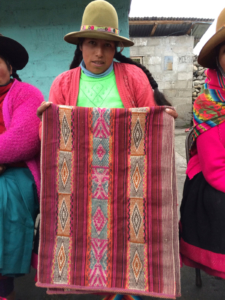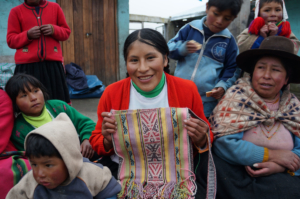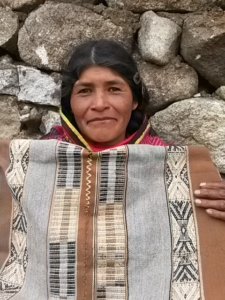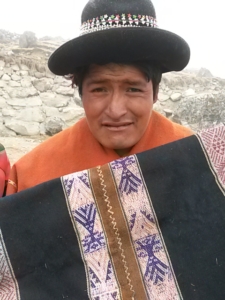Q’ero Weaving
Textile experts worldwide recognize the excellence of Q’ero weavings, with their even yarns and complex, double-sided designs. Yarns are hand spun from alpaca or sheep wool, and then dyed and woven.
Every detail of a Q’ero weaving conveys meaning, including the colors, symbols, spin of the yarns, and placement of each element woven into the textile. The cloth is formed from two pieces connected in balance, just as the male and female in nature are interconnected with harmony and balance.
Visual symbols and elements often include lightning, crop fields, inti (sun), chunchu (dancer), mayu (river), ch’aska (star), t’ika (flower), and qocha (lake). Many symbols carry more complex meanings that are not easily translated. The meanings conveyed in the patterns vary and depend on the experience and personality of the weaver.
As in all aspects of Q’ero life, textile patterns honor Pachamama and express their interconnectedness with the natural world.
Textile weaving is the single source of income for many Q’ero villages. 100% of the purchase price of textiles from the Heart Walk Foundation’s tribal store goes to support our projects in the highlands. Shop Now!
An Integral Part of Q’ero Life
Q’ero women weave everyday clothes, blankets, potato bags, coca leaf bags, ponchos, and scarves. One of the most important textiles a woman will weave is called a “lliqlla.” This ceremonial cloth is worn around a woman’s shoulders during important events and festivals, and is their legacy. Their family’s world views and inherited knowledge is passed down generation to generation on their lliqlla.
The men of Q’ero braid ropes of alpaca hair and knit the distinctive and traditional ch’ullo. This conical hat is made using 5 knitting needles. They often sew beads into symbols on their hats, which can demonstrate the virtue of patience in courtship practices!
Q’ero weavings reflect sacred symbols of the Andes that express the cosmic vision of the Q’ero people. Each textile is unique, and all weavers carry the patterns in their minds. They weave as they see all of life — as a whole tapestry, as the entire fabric of existence.







